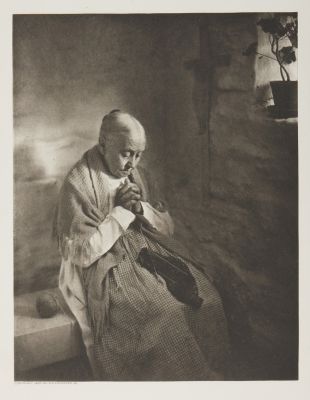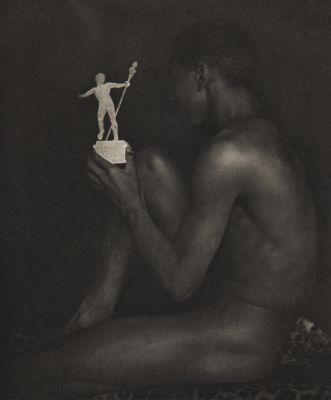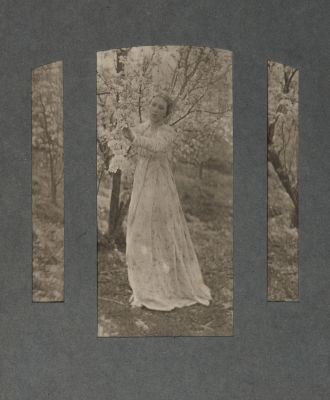
Title
La CigaleArtist
Farnsworth, Emma J. (American, 1860-1952)Publication
American Pictorial Photography, Series OneDate
1900 plate (1899 negative)Process
PhotogravureAtelier
Photochrome Engraving Company, New YorkImage Size
15.8 x 12.5 cm
It was in portfolio form that the photogravures of Camera Notes best attained stature as independent works of art. While the journal’s gravure plates were always beautifully presented and greatly admired, they, nonetheless, remained a part or a larger whole—an issue of a magazine. Fully aware of this containerization, Stieglitz undertook two portfolio projects with Camera Notes gravures to further legitimize their artistic value. And, once again, he simultaneously promoted photography as a form of art and photogravure as a means of original image making. Published in 1899 and 1901 by Stieglitz’s publications committee of the Camera Club of New York, each portfolio contained eighteen photogravures, almost exclusively printed from the same plates used for Camera Notes. What Stieglitz was doing here was asserting that the photogravures of Camera Notes were, in fact, worthy individual contemplation as artistic objects in their own right. By providing portfolios of loose gravure plates he both promoted the value of Camera Notes as a whole and made it possible for single images to be framed and exhibited without dismantling issues of the magazine. Features of the portfolios themselves pointed to the significant and collective nature of the plates. Both sets were strictly limited to a numbered edition of one hundred fifty copies, most of which were subscribed to before publication. Subscribers were personally honored by having their name printed in their own copy, and each portfolio was signed by Stieglitz. A well-designed title page and table of contents, handsomely printed in red and black, accompanied the plates, all of which were enclosed in a green cloth-covered case stamped in gold with the seal of the Camera Club of New York. Of course, the photogravures themselves attracted the most attention. Printed either on transparent tissue or heavy stock, these gravures mimicked their counterparts in Camera Notes in both size and color. Many of them were trimmed and mounted on carefully chosen colored papers, like only a few of the photogravures in Camera Notes. These paper mounts were almost twice the size of the pages in Camera Notes. Giving the portfolio gravures a great deal of breathing room and endowing them with a rarified sensibility. [1]
Emma Justine Farnsworth was born on October 16, 1860, in Albany, New York, where she lived her full ninety-one-year life. The earliest known record of her exhibiting photographs is the second Joint Exhibition of 1888, where three of her pictures were seen. Her work consisted primarily of genre scenes and figure studies.
Early on, Farnsworth took to illustrating books with her sentimental photographs. In 1892, In Arcady appeared, featuring six tipped-in photogravures printed on tissue, picturing classically draped women in the open air, with birds, harps, and children. Two other titles with images by her were published—both children’s books, also using tissue gravures tipped onto the pages. In 1893, E. P. Dutton and Company issued William Croswell Doane’s Sunshine and Play-Time, which prominently credited Farnsworth on both the cover and title page. Two years later, the same publisher put out Little Lad Jamie, a story by Mary D. Brine, with the very same set of eight photogravures, but no acknowledgment of their maker.
Farnsworth drew the attention of Alfred Stieglitz. In 1893, she once again showed in the Joint Exhibition, organized by the country’s three leading camera clubs (in New York, Philadelphia, and Boston) and was the only woman to win a medal, prompting Stieglitz to consider her the country’s strongest lady amateur. In 1897, her work comprised the second in an important series of solo exhibitions presented by the Camera Club of New York, of which Stieglitz was a leading member. And three years later, he included an image by her as a photogravure in the January 1900 issue of Camera Notes, printed in brilliant orange ink.
Farnsworth’s pictures were reproduced most frequently during the 1890s. They appeared in the American Amateur Photographer (1893, 1899), Photographic Times (1891, 1892, 1896, 1899, 1900), and Sun and Shade (1893). They were included in two deluxe portfolios of photogravures, issued on the occasion of Berlin’s annual International Exhibition of Amateur Photography in 1896 and 1897. Two years later, the Camera Club of New York also featured one of her gravures in the portfolio American Pictorial Photography I.
After the 1893 Joint Exhibition, Farnsworth continued to exhibit through the decade. She showed at the World’s Columbian Exposition (Chicago), Hartford Camera Club, Toronto Camera Club, Royal Photographic Society, and in photographic salons in London, Paris, Pittsburgh, and Washington, D.C. In 1900, Francis Benjamin Johnston included her in the important show American Women Photographers, presented at the Paris Exposition. Shortly before this show, Farnsworth wrote to Johnston that she had largely stopped photographing, but was proud of the more than twenty-five medals she had earned, at exhibitions in Canada, England, France, Germany, Italy, India, and the United States. Johnston, after returning from Paris, included Farnsworth in the series of articles she wrote on "The Foremost Women Photographers in America," for Ladies’ Home Journal (August 1901). Her pictures appeared only sporadically after 1900. They were last seen in exhibitions in 1912, at a Kodak competition in New York and at the Sweat Memorial Art Museum in Portland, Maine.
By 1915, Farnsworth had turned her attention to helping people in Europe adversely affected by World War I. The New York Times reported that she was chairman of the Women’s Section of the Commission for Relief in Belgium, which made Albany its New York State headquarters. She died of cardiac failure, on January 23, 1952. [2]
References
[1] Peterson Christian A et al. Alfred Stieglitz’s Camera Notes. 1st ed. Published by the Minneapolis Institute of Arts in Association with W.W. Norton 1993.
[2] Christian A. Peterson Pictorial Photography at the Minneapolis Institute of Arts (Christian A. Peterson: Privately printed, 2012)
Greenough, Sarah, and Alfred Stieglitz. Alfred Stieglitz: The Key Set : the Alfred Stieglitz Collection of Photographs. Washington, D.C: National Gallery of Art; New York: Harry N. Abrams, 2002. p. 938



